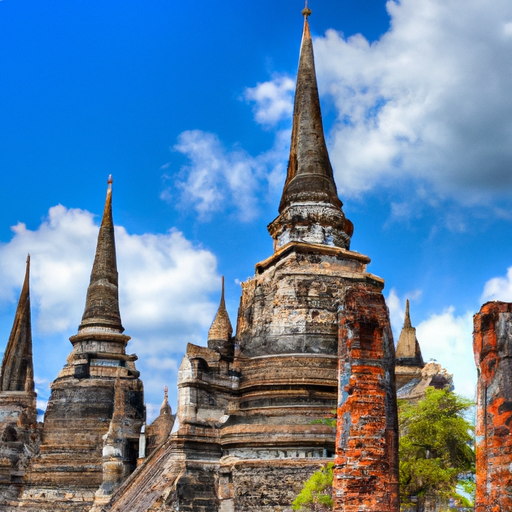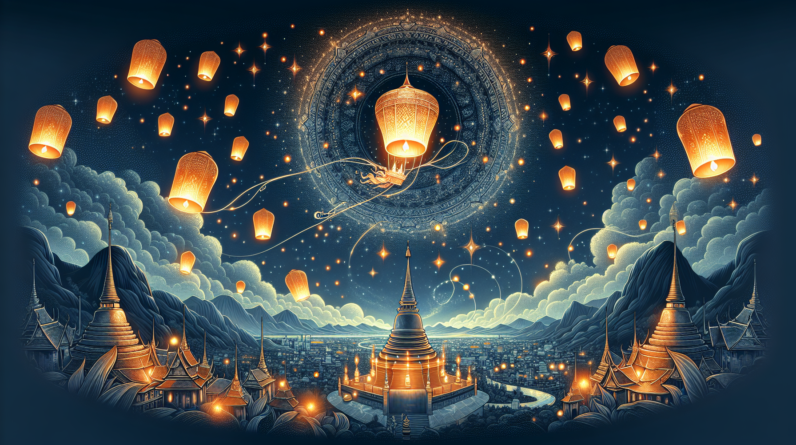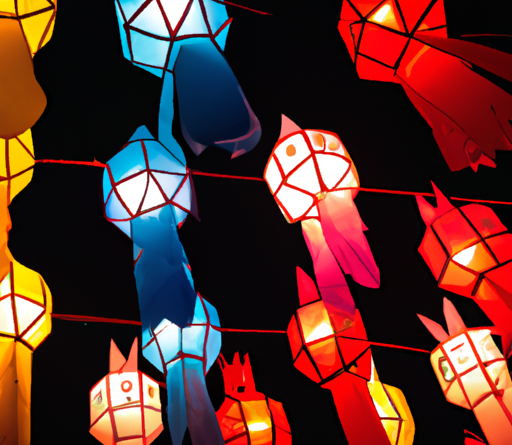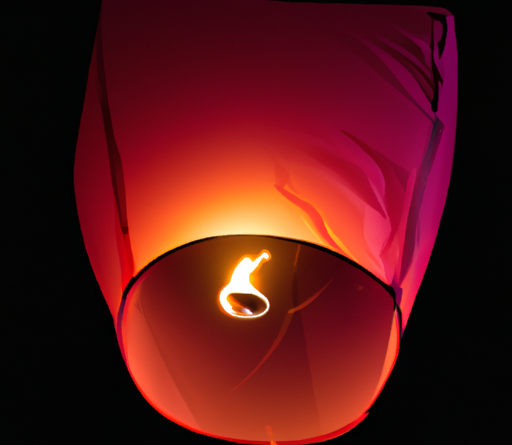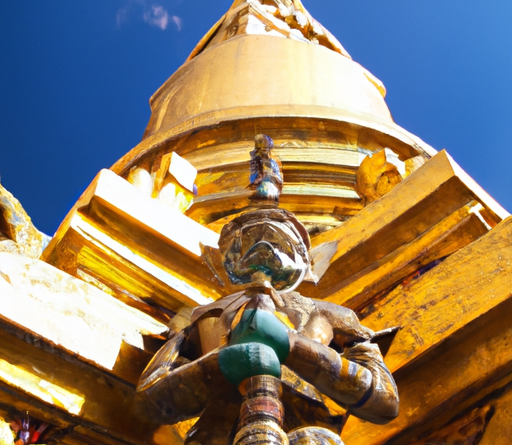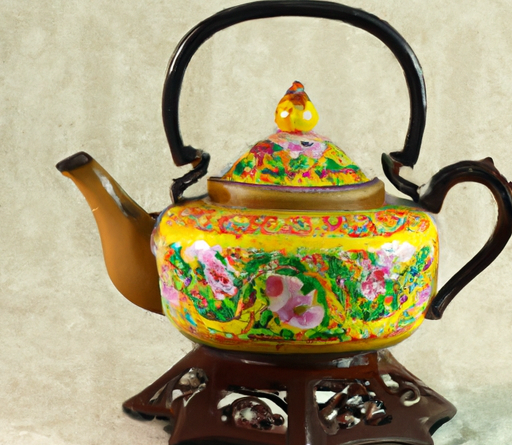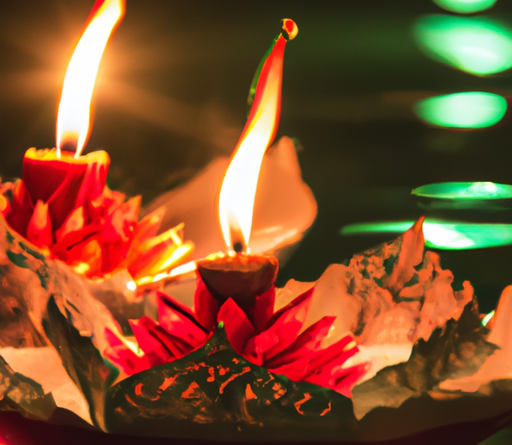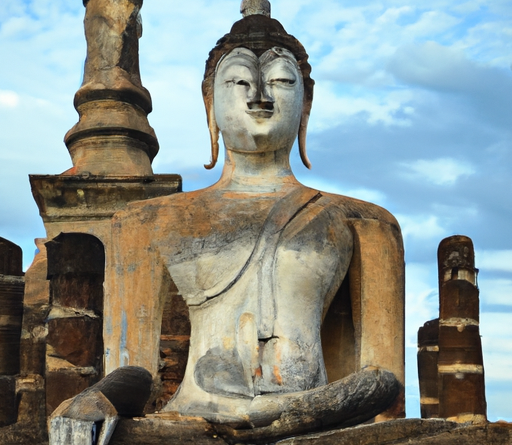
Thailand is known for its stunning beaches, vibrant culture, and delicious cuisine. But beyond the typical sightseeing spots, there lies a hidden treasure trove of UNESCO World Heritage Sites that are waiting to be explored. From the ancient ruins of Ayutthaya to the lush forests of Khao Yai National Park, these sites offer a glimpse into Thailand’s rich history and natural beauty. So, if you’re looking for a unique and immersive travel experience, it’s time to unravel Thailand’s UNESCO heritage and discover the wonders that lie beyond the beaten path.
Khmer Temples of Sukhothai
Introduction to Khmer Temples
In the heart of Thailand, lies the enchanting province of Sukhothai, home to a collection of ancient Khmer temples. These temples, built by the Khmer Empire during the 13th century, are a testament to the rich history and cultural heritage of the region. Each temple is a masterful example of Khmer architecture, characterized by intricate carvings, towering spires, and grand entrances. Exploring these temples is like stepping back in time and immersing yourself in the ancient world of Sukhothai.
Historical significance of Sukhothai
Sukhothai holds great historical significance as it was the capital of the Kingdom of Sukhothai, the first kingdom of Thailand, from the 13th to the 15th century. During this time, the kingdom flourished economically, culturally, and politically. The Khmer temples in Sukhothai reflect the influence of the Khmer Empire and their control over the region. The meticulously preserved ruins offer a glimpse into the past, allowing visitors to appreciate the grandeur and architectural achievements of the ancient civilization that once thrived here.
Exploring the ruins of Sukhothai
A visit to Sukhothai is incomplete without exploring the ruins scattered throughout the area. The Sukhothai Historical Park, a UNESCO World Heritage Site, is home to the majority of the temples and ruins. This vast park spans over 70 square kilometers and is divided into five zones: Central, North, East, South, and West. Each zone offers a unique set of temples and structures, providing visitors with a diverse and immersive experience.
The iconic Wat Mahathat
One of the most iconic temples in Sukhothai is Wat Mahathat, located in the Central Zone of the Sukhothai Historical Park. This temple is renowned for its grand central pagoda, surrounded by smaller stupas. The main attraction, however, is the serene and graceful Buddha statues that adorn the temple. These statues display the distinct Sukhothai style, with their gentle smiles and elegant postures. Wat Mahathat is a must-visit for anyone interested in experiencing the spiritual and artistic wonders of Sukhothai.
Wat Si Chum: the giant Buddha
Another jewel of Sukhothai is Wat Si Chum, famous for its colossal Buddha statue. As you enter this temple, you will be greeted by a massive Buddha, standing at an impressive 15 meters tall. The statue, known as Phra Achana, is enclosed within a narrow chamber that requires visitors to walk through a dimly lit corridor. The experience of standing before this enormous Buddha is awe-inspiring and humbling, making Wat Si Chum an essential stop for those seeking an unforgettable spiritual encounter.
Experiencing the Ramkhamhaeng National Museum
To gain a deeper understanding of Sukhothai’s history and the ancient civilization that once thrived here, a visit to the Ramkhamhaeng National Museum is highly recommended. This museum showcases a remarkable collection of artifacts, including sculptures, ceramics, and historical relics. The exhibits offer insights into the daily life, culture, and artistry of the Sukhothai period. The museum provides an educational and informative experience that enhances the appreciation of Sukhothai’s rich cultural heritage.
Historic City of Ayutthaya
Overview of Ayutthaya’s history
Ayutthaya, located just north of Bangkok, was once the flourishing capital of the Kingdom of Ayutthaya. From the 14th to the 18th century, it was a vibrant and prosperous city, serving as the center of political, economic, and cultural activities. Tragically, in 1767, the city was invaded and destroyed by the Burmese, leaving behind a legacy of ruins and a glimpse into its glorious past.
Visiting Ayutthaya Historical Park
Today, Ayutthaya is recognized as a UNESCO World Heritage Site and its historical park is a popular destination for visitors seeking to witness the remnants of its former splendor. The Ayutthaya Historical Park is a vast area filled with ancient temples, palaces, and other structures, all of which provide a glimpse into the city’s glorious past. Exploring the park allows you to immerse yourself in Ayutthaya’s rich heritage and appreciate the architectural wonders of the time.
Admiring the magnificent Wat Phra Si Sanphet
One of the highlights of Ayutthaya’s historical park is Wat Phra Si Sanphet, an impressive temple that was once the royal temple of the Kingdom of Ayutthaya. The temple is known for its three towering chedis (pagodas) that glisten under the sun, symbolizing the past glory of the kingdom. Today, the temple stands as a prominent landmark, inviting visitors to admire its architectural beauty and reflect on the historical significance it holds.
Exploring the ruins of Wat Mahathat
Another prominent temple within the historical park is Wat Mahathat, famous for its iconic Buddha head entwined in the roots of a banyan tree. This captivating sight has become a symbol of Ayutthaya, representing the city’s resilience and enduring spirit. Exploring the ruins of Wat Mahathat allows you to appreciate the intricate details of the temple’s architecture while marveling at the serendipitous beauty of nature and history intertwined.
Discovering the Ayutthaya Elephant Kraal and Royal Elephant Museum
Ayutthaya’s rich history is closely intertwined with elephants, as these majestic creatures played a significant role in the kingdom’s economy and warfare. A visit to the Ayutthaya Elephant Kraal and Royal Elephant Museum is a unique opportunity to learn about the historical importance of elephants in Ayutthaya’s society. The museum showcases artifacts related to elephants, including ancient elephant equipment and royal howdahs. Additionally, visitors can witness demonstrations of traditional elephant training techniques, further immersing themselves in Ayutthaya’s fascinating past.
Taking a boat tour along the Chao Phraya River
To fully appreciate the beauty and grandeur of Ayutthaya, a boat tour along the Chao Phraya River is highly recommended. This scenic journey allows you to witness the city’s ancient ruins from a different perspective, with the tranquil river providing a serene backdrop to the historical sites. The boat tour also offers a chance to explore the nearby Bang Pa-In Palace, a stunning palace complex that blends Thai, Chinese, and European architectural styles.
Ban Chiang Archaeological Site
Introduction to Ban Chiang
In the northeastern province of Udon Thani, lies the Ban Chiang Archaeological Site, a testament to Thailand’s prehistoric past. This site is one of Southeast Asia’s most significant archaeological discoveries, uncovering a civilization that dates back over 5,000 years. Ban Chiang offers a unique opportunity to delve into the mysteries of ancient Thailand and gain insights into the early cultures that thrived in the region.
Understanding the prehistoric era of Ban Chiang
Ban Chiang is renowned for its remarkable pottery, which provides valuable insights into the lifestyle and artistic abilities of the prehistoric people who inhabited the region. The pottery features intricate designs and intricate shapes, showcasing the sophisticated craftsmanship of the time. In addition to pottery, the archaeological site has also revealed evidence of bronze metallurgy, indicating the technological advancements of the ancient civilization.
Exploring the Ban Chiang National Museum
To fully appreciate the significance of Ban Chiang’s archaeological findings, a visit to the Ban Chiang National Museum is essential. The museum houses a diverse collection of artifacts, including pottery, bronze tools, jewelry, and skeletal remains. The exhibits are curated in a way that allows visitors to understand the history and culture of the ancient civilization that once called Ban Chiang home. A visit to the museum offers a glimpse into the daily life, beliefs, and artistic expressions of the prehistoric era.
Visiting excavation sites
To truly immerse yourself in the wonders of Ban Chiang, consider visiting the excavation sites scattered throughout the area. These sites provide a first-hand experience of the ongoing archaeological efforts to unravel the mysteries of the past. Visitors can witness the meticulous excavation process, interact with archaeologists, and learn about the latest discoveries. Exploring the excavation sites offers a unique opportunity to witness history being uncovered and to contribute to the preservation of Thailand’s cultural heritage.
Admiring the ancient pottery and artifacts
One of the highlights of Ban Chiang is the opportunity to view the ancient pottery and artifacts up close. The intricate designs and vibrant colors of the pottery reflect the artistic prowess and creativity of the prehistoric civilization. The artifacts offer a glimpse into the daily life, rituals, and religious practices of the ancient inhabitants. Admiring these ancient treasures allows you to connect with the people who once thrived in Ban Chiang and appreciate their contributions to Thailand’s rich cultural heritage.
Thungyai-Huai Kha Khaeng Wildlife Sanctuaries
Introduction to the wildlife sanctuaries
Located in western Thailand, the Thungyai-Huai Kha Khaeng Wildlife Sanctuaries are a haven for biodiversity and are recognized as a UNESCO World Heritage Site. Covering a vast area of over 600,000 hectares, these sanctuaries are home to a diverse range of plant and animal species, including several rare and endangered ones. Exploring these sanctuaries is like stepping into a pristine wilderness, where nature’s wonders await at every turn.
Biodiversity and significance of Thungyai-Huai Kha Khaeng
Thungyai-Huai Kha Khaeng Wildlife Sanctuaries boast a staggering level of biodiversity, making it one of the most important conservation areas in Southeast Asia. The sanctuaries are home to rare and endangered species such as the Indochinese tiger, Asian elephant, gaur, and Eld’s deer. The preservation of these habitats is crucial for the long-term survival of these species, highlighting the significance of Thungyai-Huai Kha Khaeng as a conservation priority.
Spotting rare and endangered species
Embarking on a wildlife safari in Thungyai-Huai Kha Khaeng offers the rare opportunity to spot some of the world’s most elusive and endangered species. Guided tours allow visitors to venture deep into the sanctuaries, increasing their chances of encountering wildlife in their natural habitat. Keep your eyes peeled for glimpses of tigers, elephants, leopards, and many other extraordinary creatures that call these sanctuaries home. Each sighting is a true privilege and a humbling reminder of the importance of conservation efforts.
Trekking and wildlife observation
For nature enthusiasts and adventure seekers, Thungyai-Huai Kha Khaeng offers an array of trekking options to explore the expansive wilderness. Guided treks take visitors through lush rainforests, along scenic rivers, and into remote areas rarely accessed by humans. Along the way, knowledgeable guides share insights about the flora and fauna, enhancing the experience and deepening your appreciation for this remarkable ecosystem. Wildlife observation platforms and hides provide additional opportunities to observe and photograph the fascinating creatures that inhabit these wild lands.
Taking a boat tour along the Mae Klong River
To fully immerse yourself in the natural beauty of Thungyai-Huai Kha Khaeng, consider taking a boat tour along the Mae Klong River. Drifting along the calm waters, surrounded by lush forests and towering cliffs, offers a serene and peaceful experience. The boat tour allows you to witness the rich aquatic biodiversity, including fish, turtles, and various bird species. The tranquil ambiance of the river ensures a relaxing journey, allowing you to unwind and connect with nature.
Historic Town of Sukhothai and Associated Historic Towns
Exploring the UNESCO-listed historic towns
Beyond the ancient temples of Sukhothai, the surrounding region is dotted with additional historic towns that offer a glimpse into Thailand’s vibrant past. These towns, collectively recognized as a UNESCO World Heritage Site, provide a comprehensive perspective on the region’s rich history and cultural heritage. Exploring these towns allows you to delve deeper into the stories of the civilizations that has shaped Thailand.
Visiting Si Satchanalai Historical Park
Si Satchanalai, located just north of Sukhothai, was once a bustling ancient city that served as the satellite capital of the Kingdom of Sukhothai. Today, Si Satchanalai Historical Park offers visitors the chance to explore the ruins and remnants of this once-thriving city. The park features well-preserved temples, ancient city walls, and Buddha statues that provide insights into the architectural, artistic, and cultural traditions of the time.
Discovering Kamphaeng Phet Historical Park
Located further to the west, Kamphaeng Phet Historical Park awaits exploration by history enthusiasts. This park boasts a collection of well-preserved ancient ruins and artifacts that showcase the grandeur of Kamphaeng Phet, another former capital of the Kingdom of Sukhothai. The park is home to numerous temples, city walls, and moats that were once vital components of the vibrant city. Exploring Kamphaeng Phet Historical Park allows you to appreciate the magnificence and resilience of this ancient civilization.
Admiring the intricate Thai architecture
One of the common threads that connect the historic towns of Sukhothai, Si Satchanalai, and Kamphaeng Phet is the intricate Thai architecture that adorns the temples and structures. The buildings exhibit elegant designs, intricate carvings, and delicate details that reflect the ingenuity and artistry of the craftsmen of the time. Admiring these architectural marvels allows you to truly appreciate the cultural and artistic heritage of Thailand while providing a visual feast for the eyes.
Exploring the local markets and food scene
Immerse yourself further in the local culture by exploring the vibrant markets and indulging in the tantalizing flavors of Sukhothai, Si Satchanalai, and Kamphaeng Phet. The markets offer a sensory delight, with bustling stalls selling a diverse range of local produce, handicrafts, and souvenirs. Sample local delicacies such as Sukhothai noodles, a savory and aromatic dish famous in the region. Exploring the local markets and food scene allows you to interact with the friendly locals and experience the authentic charm of these historic towns.
Dong Phayayen-Khao Yai Forest Complex
Introduction to Dong Phayayen-Khao Yai
The Dong Phayayen-Khao Yai Forest Complex spans across the provinces of Nakhon Ratchasima, Prachinburi, Nakhon Nayok, and Saraburi in central Thailand. This UNESCO World Heritage Site is a haven for nature enthusiasts and wildlife lovers. The complex encompasses two national parks, Khao Yai and Thap Lan, and features diverse landscapes, rich biodiversity, and numerous natural attractions.
Ecological significance and biodiversity
The Dong Phayayen-Khao Yai Forest Complex is of immense ecological significance, preserving the largest intact monsoon forest in mainland Southeast Asia. The complex is home to an impressive array of wildlife, including elephants, tigers, gibbons, and hornbills. The diverse range of ecosystems, from dense forests to grasslands and waterfalls, creates a habitat that supports an extraordinary level of biodiversity. Exploring this complex is like stepping into a living laboratory, witnessing the intricate web of life that thrives in this pristine wilderness.
Discovering the Khao Yai National Park
Khao Yai National Park, one of the flagship parks within the complex, offers visitors an unrivaled opportunity to discover the natural wonders of the region. Dense forests, rolling hills, and towering waterfalls adorn the landscape, creating a breathtaking backdrop for exploration. Trekking trails lead adventurous spirits to hidden gems, such as the Haew Narok Waterfall, one of Thailand’s tallest waterfalls. Wildlife watching, bird spotting, and night safaris are just a few of the activities that allow visitors to experience the remarkable biodiversity of Khao Yai National Park.
Exploring the waterfalls and hiking trails
Dong Phayayen-Khao Yai Forest Complex is a paradise for outdoor enthusiasts, with an extensive network of hiking trails that encompass stunning waterfalls and scenic viewpoints. From the famous Haew Narok Waterfall to the picturesque Haew Suwat Waterfall, each cascade brings its own unique allure. The hiking trails cater to different levels of fitness, ensuring that visitors of all abilities can immerse themselves in nature and witness the beauty of the complex up close.
Wildlife watching and bird spotting
The forest complex is home to an incredible diversity of wildlife, making it a dream destination for wildlife enthusiasts. Early morning or late afternoon excursions offer the highest chances of spotting animals such as elephants, deer, and even elusive tigers. The rich avifauna of the region makes it a paradise for birdwatchers, with over 380 species recorded. Patient observation may reward you with the sighting of colorful hornbills, raptors, and other endemic and migratory bird species.
Sukhothai Historical Park
Overview of Sukhothai Historical Park
Sukhothai Historical Park, located in the province of Sukhothai, is a UNESCO World Heritage Site and a must-visit destination for history buffs and culture enthusiasts. Covering an area of approximately 70 square kilometers, the park is home to the ruins of the ancient city of Sukhothai, which was the capital of the Kingdom of Sukhothai from the 13th to the 15th century. The park houses a myriad of well-preserved temples, ancient structures, and Buddha statues, providing visitors with a glimpse into the grandeur of the past.
Exploring the central zone
The central zone of Sukhothai Historical Park is the heart of the ancient city, housing some of the most iconic and impressive temples. From the moment you enter, you will be captivated by the peaceful and serene ambiance that permeates the area. The central zone is home to Wat Mahathat, Wat Sa Si, and Wat Trapang Ngoen, among others. Each temple tells its own story and showcases unique architectural features, such as the lotus-shaped stupas and intricately carved Buddha statues. Exploring the central zone allows you to immerse yourself in the spiritual and artistic essence of Sukhothai.
Admiring the iconic Buddha statues
One of the highlights of Sukhothai Historical Park is its collection of iconic Buddha statues, each exuding a sense of divine tranquility. The statues are characterized by the subtle and elegant Sukhothai style, with gentle smiles and graceful postures. The most famous of these statues is the Standing Buddha of Wat Si Chum. This colossal statue stands at an impressive 15 meters tall and offers a humbling and awe-inspiring experience. Other notable statues, such as the Walking Buddha of Wat Sa Si and the Reclining Buddha of Wat Si Chum, also deserve admiration for their incredible craftsmanship and spiritual significance.
Exploring the northern and western zones
While the central zone of Sukhothai Historical Park may be the most popular, the northern and western zones offer their own unique treasures waiting to be discovered. The northern zone boasts Wat Chang Lom, known for its elephant-shaped columns, and Wat Chetuphon, home to a well-preserved temple and ancient structures surrounded by a scenic moat. In the western zone, Wat Phra Phai Luang and Wat Sri Sawai take center stage, with their distinct architectural features and historical significance. Exploring these zones provides a more comprehensive experience of Sukhothai’s cultural heritage, as well as opportunities for quieter and more intimate encounters with the ruins.
Cycling around the park
To fully immerse yourself in the wonders of Sukhothai Historical Park, consider renting a bicycle and embarking on a leisurely ride through the park’s mesmerizing landscapes. Cycling allows you to explore at your own pace, stopping at temples, viewpoints, and lesser-known corners of the park. The park’s well-maintained pathways offer a safe and enjoyable cycling experience, with signs providing guidance and information about the various sites along the way. Cycling allows you to appreciate the beauty of the park’s natural surroundings while discovering hidden gems off the beaten path.
Enjoying the traditional performances
To enhance your visit to Sukhothai Historical Park, consider timing your visit to coincide with the evening performances that take place within the park grounds. These traditional performances showcase the rich cultural heritage of Sukhothai, featuring graceful dances, traditional music, and captivating storytelling. The performances provide a unique opportunity to witness the traditions and customs of the region, offering a deeper understanding of the historical and cultural context of Sukhothai. The enchanting atmosphere of the performances adds an extra layer of magic to your experience at the park.
The Ancient City of Ayutthaya
Overview of Ayutthaya’s ancient city
The Ancient City of Ayutthaya, located just north of Bangkok, is a UNESCO World Heritage Site and a treasure trove of historical and architectural wonders. Once a majestic and bustling capital, Ayutthaya was founded in the 14th century and was one of the most prosperous cities in Asia. Today, the remnants of this ancient city offer visitors a glimpse into its glorious past, with ruins, temples, and palaces that evoke the grandeur of Ayutthaya’s illustrious history.
Visiting the Ayutthaya Historical Park
A visit to the Ayutthaya Historical Park is a journey through time, allowing you to explore the vast complex of ruins that were once part of this magnificent city. The historical park encompasses numerous temples, ancient buildings, and monumental structures, all testaments to Ayutthaya’s stature as a powerful and prosperous capital. The park is divided into different zones, each offering its own set of architectural marvels, such as Wat Phra Si Sanphet, Wat Mahathat, and Wat Chaiwatthanaram. Exploring the historical park enables visitors to appreciate the architectural, cultural, and religious significance of these ancient edifices.
Exploring the Royal Palace
The Royal Palace, also known as the Grand Palace, is a testament to the opulence and grandeur of Ayutthaya’s royal court. Although much of the palace complex was destroyed during the Burmese invasion in 1767, some structures and remnants still stand. The surviving stone pillars and stunning gateways provide a glimpse into the magnificence of the royal palace. Exploring the grounds allows visitors to imagine the splendor of the past, as they meander through the courtyards and immerse themselves in the sense of regal grandeur that once permeated this iconic site.
Admiring the beautiful temples
Ayutthaya is renowned for its magnificent temples, each boasting unique architectural styles and religious significance. Wat Phra Si Sanphet, the royal temple, is one of the most visually striking with its three towering chedis (pagodas). The iconic Buddha head nestled within the roots of a banyan tree at Wat Mahathat has become an iconic image of Ayutthaya. Other notable temples, such as Wat Chaiwatthanaram and Wat Lokaya Sutha, offer their own distinctive features and captivating beauty. Admiring these temples provides a spiritual and aesthetic experience, connecting visitors to the spiritual traditions and history of Ayutthaya.
Taking a river cruise
To soak in the panoramic views of Ayutthaya’s ancient city, consider taking a river cruise along the Chao Phraya River. The river cruise offers a unique perspective of the city’s historical sites, allowing visitors to appreciate the grandeur of the temples and palaces from a different vantage point. Cruising along the river also provides an opportunity to observe the local way of life, with traditional stilt houses, fishing boats, and riverside communities dotting the riverbanks. A river cruise is a tranquil and picturesque way to round off your exploration of Ayutthaya’s ancient city.
Phanom Rung Historical Park
Introduction to Phanom Rung
Located in the province of Buriram, Phanom Rung is an ancient Khmer complex that dates back to the 10th century. This architectural gem boasts intricate carvings, towering spires, and panoramic views, all encapsulating the grandeur and mystique of the Khmer Empire. Phanom Rung is a revered and sacred site, attracting both history enthusiasts and spiritual seekers with its unparalleled beauty and historical significance.
Discovering the ancient Khmer complex
Phanom Rung is home to a meticulously preserved collection of temples and structures, showcasing the architectural brilliance of the Khmer civilization. The complex encompasses the main sanctuary, known as Prasat Hin Phanom Rung, along with other structures that form a vast religious and ceremonial site. The temple complex features intricately carved lintels, stunning bas-reliefs, and majestic stairways, all of which highlight the skill and artistic mastery of the Khmer builders. Exploring the ancient complex enables visitors to appreciate the grandeur and intricacies of Khmer architecture.
Exploring the Prasat Hin Muang Tam
Located just a short distance from Phanom Rung is the Prasat Hin Muang Tam, another remarkable Khmer temple complex. The complex is characterized by its serene and secluded setting, surrounded by lush greenery and vibrant flora. The main temple, Prasat Muang Tam, is a masterpiece of Khmer architecture, featuring intricately carved lintels and beautiful sandstone sculptures. The complex also includes several satellite temples and ponds, creating a tranquil and picturesque environment that invites exploration and reflection.
Admiring the panoramic view from Phanom Rung
As you ascend the grand staircase to the main sanctuary of Phanom Rung, you will be rewarded with a stunning panoramic view of the surrounding countryside. The temple’s elevated position on an extinct volcano offers sweeping vistas, allowing you to soak in the beauty of the landscape. The sight of Phanom Rung against the backdrop of clear skies and rolling hills is nothing short of awe-inspiring. Spend a moment to absorb the tranquility and appreciate the timeless beauty that defines Phanom Rung.
Experiencing the annual Phanom Rung Festival
For a truly immersive experience, consider timing your visit to coincide with the annual Phanom Rung Festival. This festival, held during the full moon in April, is a celebration of the complex’s historical and cultural significance. The festival showcases traditional performances, including ancient dances, music, and theatrical reenactments, bringing the site to life and encapsulating the spirit of the Khmer Empire. Attending the Phanom Rung Festival provides an unforgettable experience, immersing you in a vibrant atmosphere of cultural heritage and spiritual reverence.
